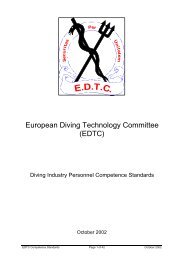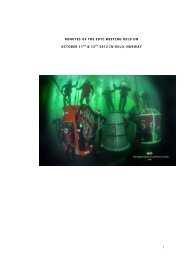Diving Industry Personnel Competence Standards - European ...
Diving Industry Personnel Competence Standards - European ...
Diving Industry Personnel Competence Standards - European ...
You also want an ePaper? Increase the reach of your titles
YUMPU automatically turns print PDFs into web optimized ePapers that Google loves.
5 Documentation<br />
This section identifies the records that need to be maintained and the other documentation that is<br />
required in order to meet the requirements of this document.<br />
It is not intended that this document will give detailed instructions, layouts etc. of the<br />
documentation involved, rather that it gives an outline upon which a national government or<br />
training/assessment organisation can base their detailed documentation.<br />
5.1 Individual Identification<br />
It is obviously important that any records maintained, certificates issued etc clearly refer<br />
to a specific individual. This is particularly important when assessing an experienced<br />
person where cheating by an impostor is more likely.<br />
Identification will normally be achieved by photographic means. It is suggested that<br />
organisations complying with this document should confirm at the start of any<br />
training/assessment that the candidate is indeed who they claim to be. This can be<br />
established by the provision of suitable official documentation bearing a photograph.<br />
Typical examples are passports, identity cards, military passes etc. The organisation<br />
would normally take a copy of such a document and lodge it in their files along with a<br />
number of photographs of the individual that can be subsequently affixed to certificates,<br />
etc.<br />
5.2 Entry Requirements<br />
Prior to any training/assessment taking place, it is clear that the requirements for entry<br />
are checked and validated. In order not to waste time, as much of this as possible<br />
should be checked well in advance of the individual commencing training/assessment.<br />
A typical routine would be for the individual to be asked to send copies of their<br />
qualifications, certificates and log books (as relevant) to the organisation carrying out<br />
the training/assessment. These could then be checked to ensure that they met the<br />
minimum entry requirements. If there were any doubts about the validity of any of the<br />
documents, then this could be checked by telephone etc.<br />
The individual would be instructed to bring the originals of all of these documents with<br />
them to the place where the training/assessment was going to take place. Upon arrival<br />
the original documents would be checked by a responsible person in the organisation<br />
and confirmed to match the copies sent earlier.<br />
The organisation would then place a copy of all of these documents in to the<br />
individual’s records, duly validated by the responsible person.<br />
5.3 Certificates Issued<br />
Upon the completion of any training/assessment based on the competences in this<br />
document, the individual should be issued with a certificate clearly stating what they<br />
have been assessed to do, the results of that assessment plus where, when and by whom<br />
it was carried out.<br />
Certificates should carry a photograph with the name of the individual and should be<br />
designed such that they are not easy to alter.<br />
If desired, a more detailed list of competences assessed with results and comments may<br />
accompany the certificate.<br />
EDTC <strong>Competence</strong> <strong>Standards</strong> March 2003 Page 29




